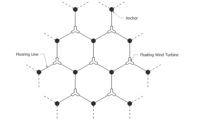High-Speed Video System Tested for Structure Monitoring

A video still of a pipe (top left) being struck by a hammer (top right) and then after motion-magnification algorithms at three frequencies (bottom) reveal movement otherwise too small to see.
PHOTOS COURTESY OF THE RESEARCHERS/MIT
Field tests of a high-speed video system that reveals distortion by exaggerating tiny deflections show promise as the basis for a new, flexible and relatively inexpensive structural health analysis tool. Researchers believe it could provide an integrated, non-contact system for structural monitoring of bridges and pipelines.
“Recently, measurements on the Memorial Bridge in Portsmouth, N.H., revealed some interesting torsional modes of vibration as valuable information in assessing the performance of the bridge,” reports researcher Oral Buyukozturk, a civil and environmental engineering professor at the Massachusetts Institute of Technology.
Other tests are planned for several structures in Boston, including the Zakim Bridge and the John Hancock and Prudential towers, as well as MIT’s Cecil and Ida Green Building in Cambridge, Mass.
The motion-magnification algorithms filter a video image into amplitude and phase signals, which are used to reconstruct a video in which the apparent motions of objects are magnified at selected frequencies.
“This [methodology] will be a valuable alternative for fast, inexpensive and very practical methods for rapid assessment of existing systems,” Buyukozturk predicts.
“There are levels of inspection, and you don’t always have to start with the highest-quality camera,” adds Buyukozturk. “Depending on your objective, perhaps you could use the camera on your cellphone for screening, and if you detect something, you could concentrate on it with a high-power camera.”
Buyukozturk says the new tool is as precise as current alternatives and has advantages because even an array of sensors “can’t achieve [the] high density of spatial measurements” inherent in a video scan.
The precision and deflections captured in laboratory trials using the video process match the results of tests conducted with accelerometers, Buyukozturk claims, but accelerometers measure movement only at their attachment location and typically cost more than $1,000 each.
Another precise, non-contact method of measuring motion, laser vibrometry, exposes a structure to a laser beam and an acoustic wave, but Buyukozturk says it is time-consuming and, like accelerometers, measures movement at only a single point at a time.
Buyukozturk co-authored a paper on the technology with lead author and graduate student Justin Chen and four others. The paper was published in the Journal of Sound and Vibration on June 9.
The paper demonstrates the method’s capability by measuring deflection of a cantilever beam and distortions in a piece of PVC pipe being struck by a hammer. The researchers used a Phantom v10 high-speed camera.
The MIT researchers are collaborating with Dirk Smit and Sergio Kapusta, chief scientists at Royal Dutch Shell. A Shell spokeswoman declined to comment on specific project plans or Royal Dutch Shell’s level of investment.
“People have been working on structural monitoring for the past 30 to 40 years, but we still don’t have an integrated system that can be used readily for structural monitoring of a bridge, let’s say, or a pipe system,” Buyukozturk says. “Our objective is to make several steps of progress toward that, with new innovative methodologies.”






